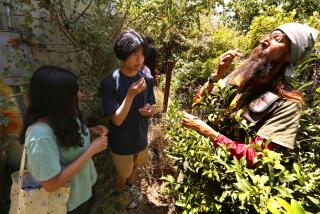Teaching Peace
No one really needed a reminder, but there one was in last week’s headlines: a 15-year-old boy accused of killing two and wounding 13 in a shooting spree at a suburban San Diego High School. One more reason programs like Herbert Hoover High School’s mountain retreats are so important.
The Glendale school recently sent most of its 700 freshmen on camping trips to the San Bernardino Mountains. Away from their regular routines and roles, the teenagers took part in workshops, role-playing games and late-night talks intended to foster a sense of community.
Funding for the retreats came from a U.S. Department of Education grant designed in part to make big schools seems smaller and more personal. The program was set up after the 1999 Columbine High School massacre in Colorado. But the Glendale school had plenty of closer-to-home reasons for applying.
Long-standing antagonism between Armenian American and Latino students last year ended in tragedy when senior Raul Aguirre was clubbed with a tire iron and stabbed in the heart in front of dozens of students. Aguirre, who did not belong to a gang, died trying to break up a fight between a Latino teenager and two Armenian Americans who had allegedly flashed gang signs at each other.
A violent incident in a school often prompts calls for a quick fix, such as increasing security or installing a metal detector. But psychologists say the long-term solution is a far slower one: Teaching kids how to get along with each other.
Columbine High School officials, who have become reluctant experts in reducing school violence, now hold seminars for students on hate speech and have a zero tolerance policy for bullying and threats. School violence researchers say that such preventive measures improve the school climate and reduce vandalism.
Next fall the Los Angeles Unified School District will institute a mandatory 20-week course on interpersonal skills for ninth-graders. Other efforts already are underway, including a pilot program at Grant High School in Valley Glen. A Cal State Northridge professor and 35 CSUN intercultural communication students work with freshmen to reduce ethnic violence on a campus plagued, like the one in Glendale, with long-simmering feuds between Armenian American and Latino students.
Conflict-resolution has been tried before, of course. So have mediation and counseling and cultural-awareness classes and peace treaties. Campus violence has not magically disappeared.
Instead of promises, such efforts make demands: Long work over the long haul. And they demand the commitment not only of students and teachers but of the larger community.
If Aguirre’s brutal death stunned Glendale residents, his heroism inspired them. Months of grief and self-examination culminated in a citywide summit on ending violence. The same community activists who helped organize the summit are helping run Hoover High’s retreats.
The hope is that those first steps taken on a snowy mountaintop will lead to other steps after the teenagers return to their 2,700-student campus.
Consider the alternative. You can probably find it in the headlines.
More to Read
Sign up for Essential California
The most important California stories and recommendations in your inbox every morning.
You may occasionally receive promotional content from the Los Angeles Times.










